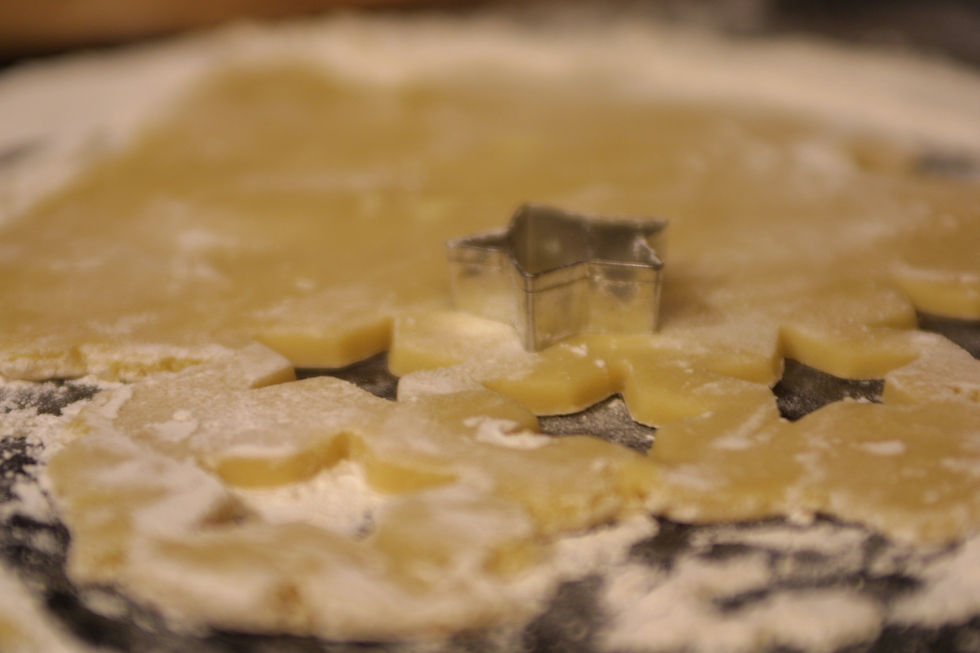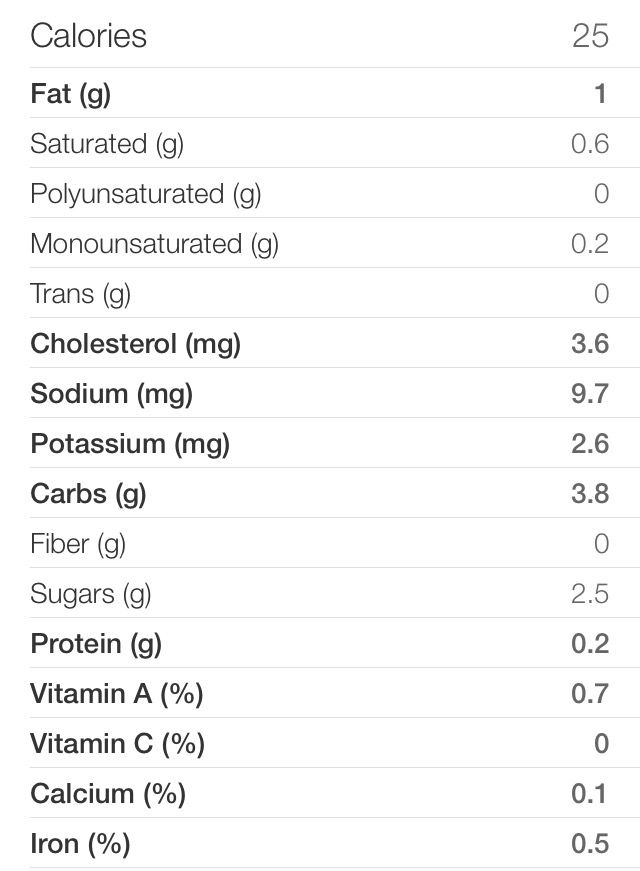
It’s Christmas Eve! Here in Virginia Beach, it certainly doesn’t feel like Christmastime with this 80 degree weather. But even without a white Christmas this year, I’m really feeling the Christmas spirit… caroling around the neighborhood (some of us in flip flops and shorts), putting up the tree and decorating it with lights and sentimental ornaments, playing Jingle Bells and Sleigh Ride on the piano, among others, and, of course, making cookies. Food is often a big part of the holiday season, whether in the form of appetizers and desserts pushed at you during a holiday party, a big Christmas ham on the 25th, or cakes and plates of cookies given as gifts. Though I am of course a proponent of eating healthy year round, I don’t think anyone should skip the festive foods at the holidays. If you constantly turn down everything this season in the name of eating healthy, you might end up feeling deprived… which is certainly not helpful for cultivating Christmas spirit in anyone.

I know a good number of people who feel guilty if they let themselves eat unhealthy food. A few others have no problem gorging on the sweets, but then end up feeling bad about themselves: the dreaded “I feel fat” (even if they look no different).
First, a few tips. Don’t feel guilty about certain foods. There are not “bad” foods and “good” foods. Why do you think experts have such a hard time deciding which food group is inherently "evil"? Is it fat? Is it carbs? The answer is that no food group is evil by any means; as I’ve always said, you need carbs, protein, and fat to sustain you. The answer in healthy eating comes in the proportions (don’t eat a 100% protein diet) as well as the total amount of food you eat (eat smaller portions).

One you get those key ideas down, start thinking about the nutrient density of the food you are eating; in other words, the nutrient bang you get for your caloric buck. This is what makes a whole wheat piece of toast a better option than a slice of cake: they both have carbs, but the toast has fiber and protein from the whole wheat, while the cake has refined sugars and flours that run through your digestion system too quickly, leaving you with a sugar high and crash (food items with refined sugars and flours have a high glycemic index), and making you hungry soon after you eat. The protein and fiber in the bread, on the other hand, not only helps you body to work better but also keeps you full longer so you eat less.

Thats the double whammy of “unhealthy foods:” they aren’t as good for you as nutrient dense foods, and you’ll also be more hungry if you eat them, causing you to eat more. Because of this, I wanted to bring up something I think is very important in order to not only eat healthily, but to feel healthy in both body and mind: the art of mindful eating.

Mindful eating is the answer to getting through the holiday season without gaining five pounds. In preliminary studies, mindful eating have been shown to reduce weight, eating disinhibition, binge eating, depression, perceived stress, physical symptoms, and negative affect… meaning that not only did it help with weight regulation, but it made the act of eating more enjoyable (no deprivation!). Mindful eating is simply eating with attention and intention. Rather than mindlessly shoving five cookies in your mouth because they are there, mindful eating teaches us to pay attention to the food that goes into our bodies, and savor every bite of it. According to “Am I Hungry?” mindful eating is more than just slow eating without distraction. This is an important part, of course, and the reason that eating from a whole bag of chips in front of the television is a bad practice. Here are some keys to mindful eating:

1. Pay attention to your physical cues for hunger. How many times a day do you eat when you aren’t actually hungry? If you are eating for another reason (emotional, stress, boredom, tiredness), could you do something else other than eat (such as exercise, socialize, or take a nap)? Often we confuse our signals for hunger, thirst, sleepiness, and emotional need.

2. What food are you choosing to eat, and why? When you have a snack, do you choose something that will nourish and satisfy you, or are you eating only because something tastes good? Pay attention to this eating for taste and not for nourishment nonjudgmentally.

3. Of course, don’t eat with distractions. When you eat dinner, put all the food on your plate so you can see how much you are eating. Don’t eat in front of the television, and if you do, put one portion in a bowl so you don’t eat the entire bag.

4. Eat slowly. Your body has natural hormones that will tell your brain when you are full. Unfortunately, these hormones take a little bit of time to give you that “full” sensation, meaning you may have already overeaten by the time you get them. If you eat too quickly and mindlessly, by the time you are full you will be really stuffed. Eat slowly so you can pay attention to your body’s cues.

5. Use smaller plates and utensils! In one study, this reduced the amount of food eaten by almost 20%. Honestly, our brains are not as good as we thin they are when telling us how much we need to eat, and how much we’ve eaten. People often underestimate consumption or overestimate needed caloric intake, and our brains can easily be tricked by things as simple as the size of the plate. Do your body a favor and use smaller plates. You won’t feel any less satisfied, and in fact, you probably won’t even notice eating less.

6. Pay attention to all of the sensations you receive from food, not just the taste. Before you dig in, pay attention to what your food looks like. Is it colorful? (This is a good thing… eat as much color as possible!) Is it mostly vegetables? When you eat, pay attention to the flavor, texture, and smells. By focusing on all the sensations associated with eating, it will become more pleasurable. In fact, we don’t only eat with our stomachs; first we eat with our eyes.

7. Try to eat just one. Seriously. Your body doesn’t need five cookies, or one-fourth of that cake. Try just one small serving to start, and notice how the food makes you feel. If it has sugar in it, accept that the food will make you crave more sugar. Notice this craving, but don’t necessarily give in to it. This is where your willpower comes in; test your limits. Don’t feel disappointed if you can’t “outwill” sweets. Over time, as you become more aware of what you are eating, this will become easier. If you are served a piece of cake, have a couple of bites and really pay attention to and savor the experience. Then either share with someone else, box up the rest, or leave the table. Since willpower isn’t an unlimited resource, try not to be too hard on yourself by staring at a half-eaten piece of cake or a plate of cookies; make your environment work for you. Also keep in mind, the more you eat of a food, the less and less you actually enjoy it. This is called sensory-specific satiety: eat bit of food is less pleasant than the one before it.

I think the key to mindful eating is recognizing when you are actually hungry, and when you aren’t. Enjoy the pleasure of food when you are hungry. I know this sounds a lot easier than it actually is. Try to focus on one thing at a time, and soon enough you’ll be a master at mindful eating, and your body and mind will be a lot happier for it.
Keep in mind that mindfulness exercises are most effective when they contain a component of nonjudgmental awareness: paying attention to something without judging it. This means you can recognize how many times a day you eat without feeling hungry, without feeling guilty or judgmental towards yourself. Simply notice more; don’t judge more.

The recipe today is the perfect one for mindful eating. I wouldn’t call it healthy by any means… but sugar cookies are one of those quintessential recipes for the holiday season. These cookies get a nice peppermint buttercream, but you can omit it or use a different flavor: chocolate, vanilla, or even almond (which give the cookies a Petit Fours flavor). I used a small star cookie cutter, which gave me over 200 little cookies from one batch of dough! Try eating just one of these cookies… but don’t feel too bad if you eat two, because each one has only 25 calories!
This is the best sugar cookie dough I have ever made: it doesn’t spread, so the cookies keep they’re shape; it’s just sweet enough, and perfect with the peppermint frosting; they can be made either soft and doughy or browned and crispy; and best of all, they are easy to make, and you probably have all of the ingredients already!
This food blog is one of my favorite things to do, and I’m thankful for all of my readers. Merry Christmas and happy New Year!

Peppermint Stars
Makes about 200 cookies (using larger cookie cutters, makes about 50 cookies)
Ingredients
Sugar cookie dough
1 cup (2 sticks) unsalted butter, room temperature
1 cup granulated sugar
2 large eggs, room temperature
1 teaspoon pure vanilla extract
3 cups all purpose flour
1/2 teaspoon salt
Peppermint buttercream
3 tablespoons melted butter
3 tablespoons milk (I used almond milk)
3 cups powder sugar
3/4 teaspoon peppermint extract, to taste
Food coloring, optional
Directions
1. In the bowl of your electric mixer (or with a hand mixer), cream the butter and sugar, on medium speed until light and fluffy (about 3 minutes). Add the eggs and vanilla, and beat
until combined. Add the salt and flour; beat until you have a smooth dough. Divide the dough in half and wrap each half in plastic wrap. Refrigerate for about one hour or until firm enough to roll.
2. Preheat oven to 350°F. Remove one half of the chilled dough from the refrigerator and, on a lightly floured surface, roll out the dough to a thickness of 1/4 inch. (Keep turning the dough as you roll, making sure the dough does not stick to the counter.) Cut out desired shapes using a lightly floured cookie cutter and transfer cookies to baking sheet. Place the baking sheets with the unbaked cookies in the refrigerator for about 15 minutes to chill the dough which prevents the cookies from spreading and losing their shape while baking. Note: If you are not going to frost the baked cookies, you can sprinkle the unbaked cookies with sparkling sugar.
3. Bake cookies for about 8-10 minutes (depending on size) or until the edges are just starting to brown. (The cookies will continue to cook a little, and will be more crispy the next day. I like my cookies doughy and soft, so I bake them for 8 minutes; they’ll still be a little doughy in the middle, and not yet brown. They will cook a little more though and keep their shape.) Remove from oven and let cookies cool on baking sheet for a few minutes before transferring to a wire rack to finish cooling.
4. Peppermint frosting: beat all frosting ingredients together until well combined. Frost cookies immediately and place in the fridge. Let the frosting harden in the fridge before stacking the cookies.



